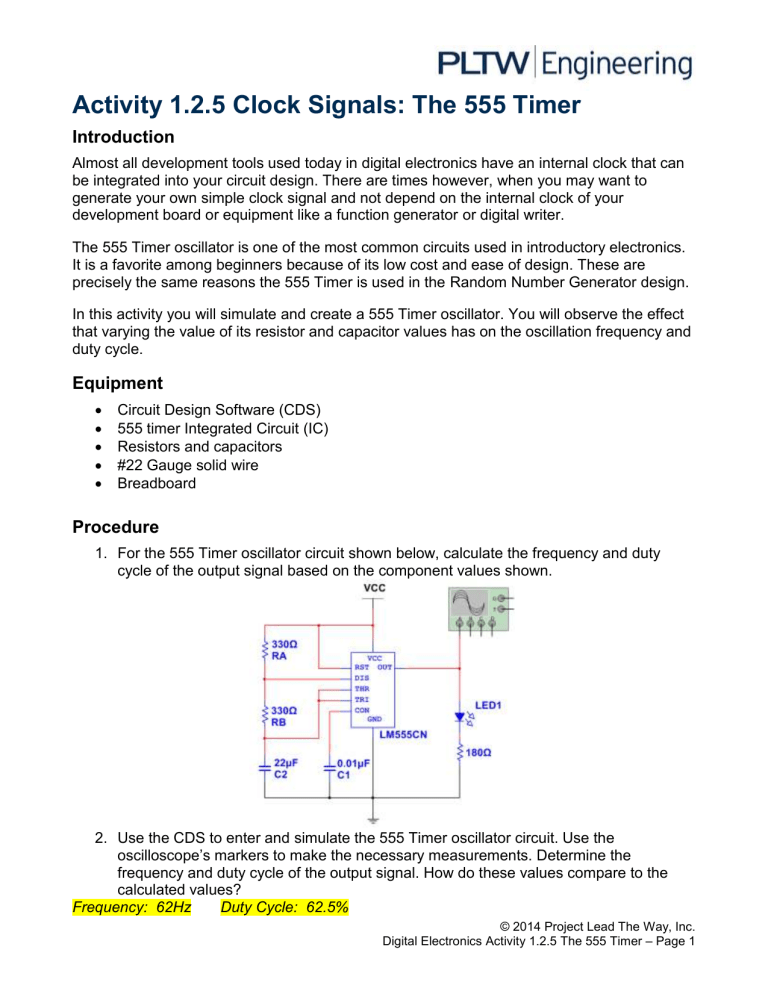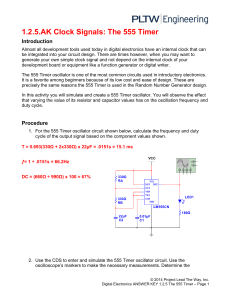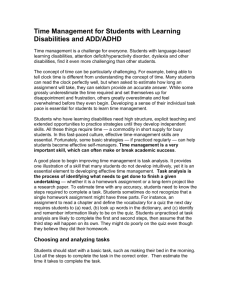File

Activity 1.2.5 Clock Signals: The 555 Timer
Introduction
Almost all development tools used today in digital electronics have an internal clock that can be integrated into your circuit design. There are times however, when you may want to generate your own simple clock signal and not depend on the internal clock of your development board or equipment like a function generator or digital writer.
The 555 Timer oscillator is one of the most common circuits used in introductory electronics.
It is a favorite among beginners because of its low cost and ease of design. These are precisely the same reasons the 555 Timer is used in the Random Number Generator design.
In this activity you will simulate and create a 555 Timer oscillator. You will observe the effect that varying the value of its resistor and capacitor values has on the oscillation frequency and duty cycle.
Equipment
Circuit Design Software (CDS)
555 timer Integrated Circuit (IC)
Resistors and capacitors
#22 Gauge solid wire
Breadboard
Procedure
1. For the 555 Timer oscillator circuit shown below, calculate the frequency and duty cycle of the output signal based on the component values shown.
2. Use the CDS to enter and simulate the 555 Timer oscillator circuit. Use the oscilloscope’s markers to make the necessary measurements. Determine the frequency and duty cycle of the output signal. How do these values compare to the calculated values?
Frequency: 62Hz Duty Cycle: 62.5%
© 2014 Project Lead The Way, Inc.
Digital Electronics Activity 1.2.5 The 555 Timer – Page 1
3. Repeat steps (1) and (2) for each set of component values in the table shown below.
Note that the shaded areas are the values that were measured from the original circuit.
RA RB C2 Period(T) Frequency( f )
100
330
22
F 13ms 74Hz
330
330
22
F 16ms
560
330
22
F 19ms
62Hz
53Hz t
H t
L
6.5ms 6.5ms
Duty Cycle
50%
10ms 6ms 62.5%
13.5ms 5.5ms 69.9%
330
100
22
F 8.5ms
330
330
22
F 16ms
330
560
22
F 23.5ms
330
330
10
F 7.0ms
117.5Hz
62Hz
42.5Hz
6.5ms 2.0ms
10ms 6ms
13.4ms 10ms
76%
62.5%
57%
136.5Hz 4.5ms 2.5ms 64.3%
330
330
22
F 16ms 62Hz 10ms 6ms 62.5%
330
330
47
F 34ms 29Hz 21ms 12ms 61.7%
4. Review the results of the data collected in step (3) of the procedure.
What effect did varying the RA have on the frequency and duty cycle?
Lowering the resistance of the RA made the frequency Higher but the Duty
Cycle lower.
Increasing the resistance of the RA made the frequency Lower but the Duty
Cycle higher.
What effect did varying the RB have on the frequency and duty cycle?
Lowering the resistance of the RB made the frequency Higher AND the Duty
Cycle also higher.
Increasing the resistance of the RB made the frequency Lower AND the Duty
Cycle also lower.
What effect did varying the C2 have on the frequency and duty cycle?
Lowering the Capacitation of C2 (by half) made the frequency Higher by more than twice as much AND the Duty Cycle higher by 1-2 percent.
Increasing the Capacitation of C2 (by half) made the frequency lower by half
AND the Duty Cycle lower by 1-2 percent.
In the previous activity you created a 4-bit counter that counted from 0-15 in binary.
We used a provided clock source. (Internal clock in the development board or a software generated clock source).
Using what you have learned about the relationships between RA, RB, C2 and how they impact the frequency output of the clock signal, create your own 555 Timer oscillator circuit on your development board.
© 2014 Project Lead The Way, Inc.
Digital Electronics Activity 1.2.5 The 555 Timer – Page 2
(Note: The simulation was helpful in determining how RA, RB, and C2 impact the 555
Timer oscillator design. However, the software simulated frequency can be affected by the processor on your computer. The frequency rate may appear slightly different in your actual design compared to your simulated design. Also, your design may be limited by the resistors and capacitors available.)
Simulation
5. Once you have your 555 Timer circuit functioning, use the clock signal to trigger the 4bit binary counter you created previously.
Breadboard
6. Create the circuit on your breadboard. (Remember you may need to use different resistor and capacitor values to find a clock signal rate you are comfortable with.
You will need to locate the datasheets for the 555 timer and 74LS74 D Flip-flop.
© 2014 Project Lead The Way, Inc.
Digital Electronics Activity 1.2.5 The 555 Timer – Page 3











